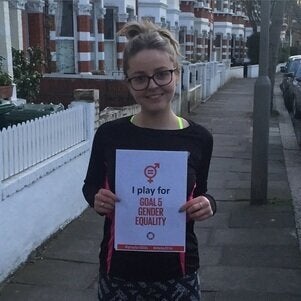Published a year ago now, the UN's 17 Sustainable Development Goals (SDGs) offer the world a framework around which global development can rally. The new goals offered, for the first time, a truly north to south appreciation of the issues and challenges facing the world today. As international development communities across the world face an increasingly challenging climate in which to tackle these issues, it is clear that new approaches are needed. One of these, I believe, is recognising the role sport can play in strengthening and enabling the UN's 17 Goals.
In my previous post I spoke about how at Connecting Clubs International (CCI) we are using cricket in Nepal to develop a programme that seeks to bring people around the table on the issue of gender inequality. I believe strongly that sport is an enabler when it comes to social issues and that it holds a unique and important place in national and international consciousness. Sport not only has the power to unite people (just think of the soldiers playing football in the trenches during WW1) but it also has a role to play in challenging the status quo and subverting traditional thinking. If sport can bring individuals and communities together for recreation and competition purposes, then it can do the same in the name of education and social development.
The SDGs act as a call to action for everyone across the world; they are far-reaching and they have the aspiration of making the world a more social, economically and environmentally just place. Whilst I won't pretend to think that football or cricket or rugby can mitigate climate change, I do believe that it can be a key component in educating younger generations about these important subjects. Indeed, the United Nations Office of Sport for Development and Peace (UNOSDP) recognises the fundamental link between the SDGs and sport through its awareness campaign #iplayforSDG. By framing the SDGs in a sports context, we are able to access groups of people that might otherwise be difficult to engage with and raise difficult topics in a more familiar setting.
At CCI and through our Cricket for Equality project we are simultaneously addressing two of the SDGs: Goal 3, Good Health and Wellbeing and Goal 5, Gender Equality. Each goal underpins a distinct component of the work we are doing with our partners in Biratnagar, Nepal. Firstly, links between health and wellbeing and sport are obvious; sport, by its very nature, requires active participation and encourages people of all ages to get fit. Through improved training, better equipment and a deeper understanding of diets and fitness, our project will help drive home our message that playing sport regularly leads to a healthier, more active lifestyle.
To tackle Goal 5, Gender Equality, we have worked with local Nepali experts and undertaken extensive research into the root causes of gender discrimination and violence within the local context. We believe that through cricket we can challenge, head on, a number of different gender equality issues and enable a pathway to change. I have previously spoken about the challenges facing Nepali women including stigmatization of women in sport, gender violence and the proliferation of rigid gender roles in society. By framing SDG 5 with cricket we are utilising one of Nepal's most loved sport to engage with men, women, boys and girls on the impacts of gender inequality and the need to tackle the issue at source. We believe that by combining high quality, gender mixed, cricket sessions to boys and girls in Nepal we can tap into and influence the next generation of 'change makers'. These individuals are the future of Nepal and it is this group that we must engage with. A robust programme tailored to local conditions and attitudes, built around sport, will ensure that the future leaders in the community are brought up with gender equality as a core value.

The SDGs are all about enabling change. They offer 17 headline objectives, broken down into over 150 targets and represent an opportunity for young people to become central to enacting that change. When you think to the climate negotiations in Paris, there was a significant presence of youngsters challenging the status quo who are key to driving real change. At CCI we believe that we need to work with communities at all levels to ensure that the next generation can become integral to shaping a better world. We believe that sport has a huge contribution to make to this, and so does the UN. From the UNOSDP website you can see the extent to which sport can help tackle injustices across the world. It demonstrates that local solutions to global issues are vital if we are to see real change and at CCI we are relentlessly pursuing this with our gender equality work.
Sport has the power to change opinions, to bring people together and to ultimately be a force for good in the world and our project is tapping into that power and ensuring the we play our part in achieving the UN's Sustainable Development Goals.
For more about our project in Nepal see www.connectingclubs.org